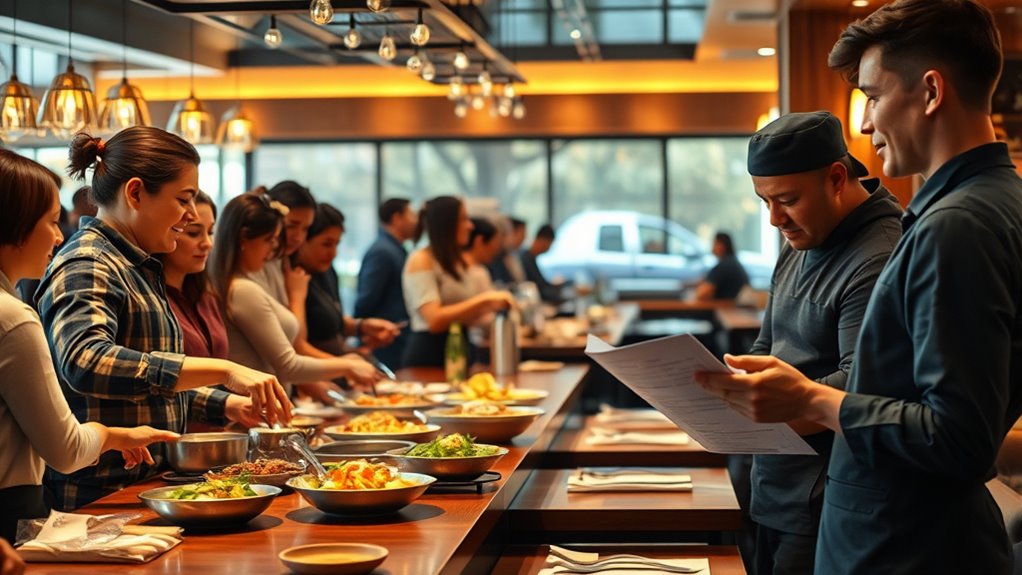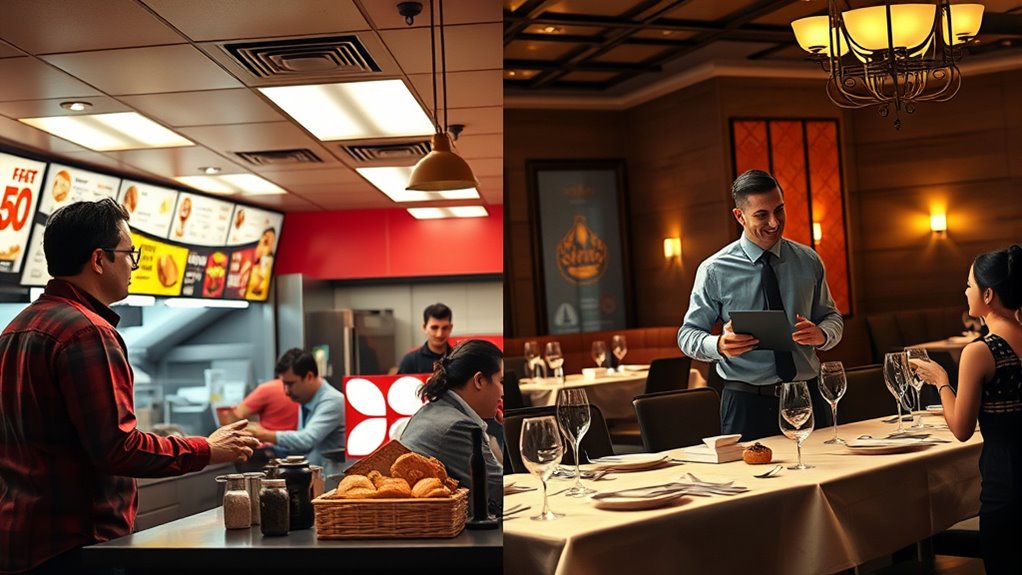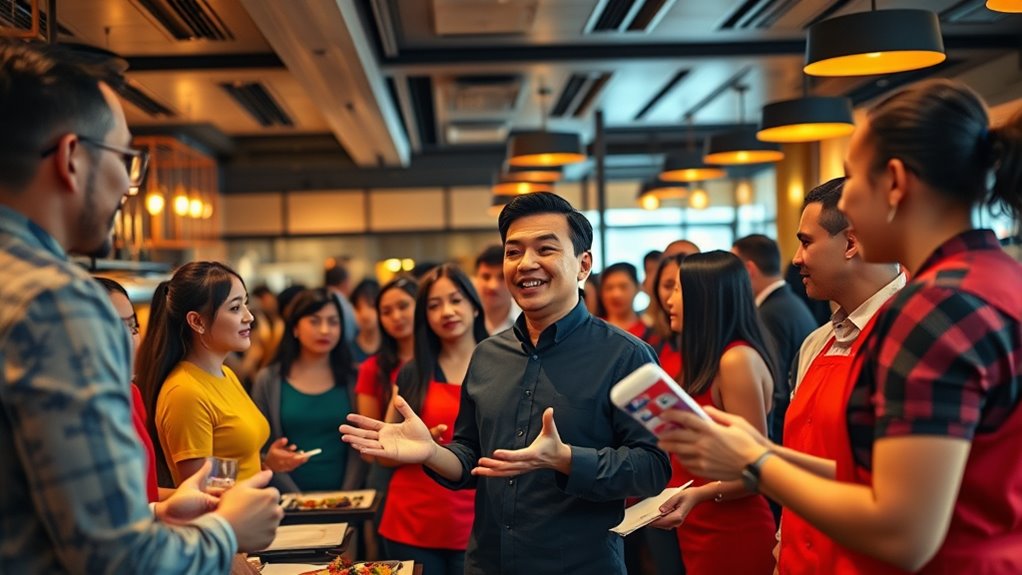Understanding the difference between transformational and transactional leadership in restaurants helps you motivate your team and improve service quality. Transformational leaders inspire staff through a shared vision and foster creativity, boosting engagement and customer satisfaction. Transactional leaders, on the other hand, rely on clear rules, rewards, and structure for consistent performance. Combining both styles can maximize team motivation and operational success. Keep exploring to discover how applying these approaches can elevate your restaurant’s performance.
Key Takeaways
- Transformational leadership inspires creativity and engagement, fostering innovation and long-term growth in restaurant teams.
- Transactional leadership emphasizes clear rules, structure, and rewards to ensure operational efficiency and consistency.
- Transformational leaders build strong staff relationships and boost motivation through vision and personal development.
- Transactional leadership maintains order and performance via goal-setting, monitoring, and reward/punishment systems.
- Combining both styles can enhance staff motivation, service quality, and adaptability in diverse restaurant environments.
Defining Transformational and Transactional Leadership

Understanding the differences between transformational and transactional leadership is key to evaluating effective management styles in restaurants. Transformational leadership focuses on inspiring and motivating your team to exceed expectations by sharing a compelling vision. You encourage innovation, foster personal growth, and build strong relationships with staff. This style aims to elevate performance through enthusiasm and empowerment. In contrast, transactional leadership emphasizes clear structures, rules, and rewards. You set specific goals, monitor performance, and use rewards or penalties to maintain order. This approach guarantees routine tasks are completed efficiently and standards are met. Both styles influence how you manage your team, but they operate through different mechanisms—one by inspiring, the other by directing. Understanding these definitions helps you choose the right approach for your restaurant’s unique needs. Recognizing symbolism in dreams and other subconscious cues can also enhance your understanding of team dynamics and individual motivations.
Key Characteristics and Principles

Transformational and transactional leadership each have distinct characteristics that shape how managers lead their restaurant teams. Transformational leaders inspire and motivate by creating a shared vision, encouraging innovation, and fostering personal development. They prioritize long-term growth, building strong relationships, and empowering staff to excel beyond routine tasks. Conversely, transactional leaders focus on clear structures, set expectations, and reward performance while correcting deviations. They rely on formal authority, use rewards and penalties, and emphasize efficiency and consistency. The core principle of transformational leadership is inspiring change through charisma and vision, whereas transactional leadership emphasizes maintaining stability through rules and procedures. Both styles operate on different philosophies, but understanding these key characteristics helps you tailor your leadership approach to your restaurant’s unique needs.
Impact on Employee Motivation and Engagement

Your leadership style directly influences how motivated and engaged your employees feel. Transformational leaders often inspire higher engagement through vision and recognition, while transactional leaders focus on clear expectations and rewards. Understanding these motivation drivers helps you create practices that boost team energy and commitment. Additionally, being aware of potential scams and risks associated with financial decisions demonstrates responsible leadership that builds trust and confidence among your team.
Motivation Drivers and Styles
Have you ever wondered what truly drives employee motivation and keeps staff engaged in a restaurant setting? Motivation styles vary, but understanding what fuels your team is essential. Some thrive on recognition and rewards, while others seek personal growth or meaningful work. Recognizing these drivers helps you tailor your leadership approach. For example, a motivated employee might respond well to intrinsic motivators like mastery, purpose, or autonomy. Here’s a quick overview:
| Motivation Driver | Description | Example |
|---|---|---|
| Recognition | Appreciation boosts morale | Employee of the month |
| Growth & Development | Desire for skills and progress | Training opportunities |
| Purpose | Meaningful work motivates | Contributing to guest satisfaction |
| Autonomy | Freedom to make decisions | Flexible scheduling |
Understanding these drivers helps you foster engagement and improve performance. Additionally, implementing diversification strategies in your leadership style can help address different motivation drivers more effectively.
Engagement Levels and Practices
Ever wonder how engagement levels directly influence employee motivation in a restaurant? High engagement boosts morale, encourages teamwork, and drives better customer service. When you foster genuine connections and recognize efforts, employees feel valued and motivated to excel. Transformational leaders often create this environment by inspiring staff and promoting open communication, leading to higher engagement. Conversely, transactional leaders might focus on strict routines and rewards, which can limit emotional investment. Effective engagement practices include regular feedback, empowering staff, and offering opportunities for growth. These strategies not only improve motivation but also reduce turnover. When employees feel connected to their work and leadership, they’re more likely to go above and beyond, ensuring a positive experience for both staff and customers. Engagement isn’t just a metric—it’s the foundation of a thriving restaurant team.
Effects on Customer Experience and Satisfaction

Your choice of leadership style directly influences how customers perceive their dining experience. When managers focus on motivating staff, service quality often improves, boosting satisfaction levels. Engaged employees tend to deliver better service, shaping positive customer perceptions and loyalty. Additionally, leadership approaches that incorporate ethical practices can foster a more trustworthy and welcoming environment for guests.
Leadership Style Impact
The leadership style adopted by restaurant managers directly influences the customer experience and satisfaction levels. If you adopt a transformational style, you inspire staff to go above and beyond, creating a warm, engaging atmosphere that delights guests. Conversely, transactional leadership emphasizes clear expectations and rewards, ensuring consistency and efficiency. Here’s how your style impacts customers:
- Transformational leaders foster genuine connections, boosting loyalty and positive reviews.
- Transactional leaders promote predictable service, reducing errors and complaints.
- Transformational approaches encourage staff to personalize guest interactions, enhancing satisfaction.
- Transactional methods maintain operational smoothness, leading to reliable service delivery.
- Incorporating water-based activities or aquatic exercises can enhance staff teamwork and stress relief, positively affecting customer interactions.
Choosing the right leadership style shapes how customers perceive their experience, affecting satisfaction and repeat visits. Your leadership directly determines whether guests leave happy or disappointed.
Service Quality Dynamics
How does service quality shape the customer experience and satisfaction in a restaurant setting? When service quality is high, you feel valued and understood, making your dining experience enjoyable and memorable. Attentive staff, timely service, and consistent food quality create a positive impression that encourages you to return. Conversely, poor service or inconsistent experiences lead to frustration and disappointment, harming your overall perception of the restaurant. Service quality influences your emotional response, perceived value, and likelihood to recommend the establishment. It acts as a key differentiator in a competitive market, directly affecting satisfaction levels. When service quality aligns with customer expectations, you’re more likely to leave satisfied, share positive reviews, and become a loyal patron. Additionally, understanding the traits of female covert narcissists or signs of a checked-out partner can help restaurant staff better recognize and address customer concerns, enhancing overall service. In essence, service quality dynamics are central to shaping your restaurant experience.
Employee Engagement Levels
When employee engagement levels are high, customers often notice the enthusiasm, attentiveness, and genuine care shown by staff, which considerably enhances their overall experience. Engaged employees are more motivated to deliver exceptional service, leading to increased satisfaction. Here’s what happens:
- They anticipate customer needs, providing personalized interactions.
- They handle issues promptly, reducing frustrations.
- Their positive attitude creates a welcoming atmosphere.
- They’re more likely to go above and beyond to ensure a memorable visit.
This heightened engagement builds trust and loyalty, encouraging repeat visits. Customers feel valued when staff show authentic enthusiasm, directly impacting their perception of your restaurant’s quality. Ultimately, high employee engagement levels foster a positive cycle of improved service and increased customer satisfaction.
Influence on Team Dynamics and Communication

Transformational and transactional leadership styles shape team dynamics and communication in distinct ways. With transformational leaders, you’re likely to experience open, inspiring communication that encourages collaboration and innovation. They motivate you by sharing a compelling vision, fostering trust and a sense of purpose within the team. This approach promotes proactive problem-solving and mutual respect, strengthening team cohesion. Additionally, transformational leadership is often associated with anime movies, which emphasize storytelling and emotional connection, thereby inspiring teams to pursue shared goals with passion. Conversely, transactional leaders emphasize clear expectations and structured communication. You might find that instructions are straightforward, with a focus on maintaining routines and meeting specific goals. Feedback tends to be more corrective or reward-based, which can create a more hierarchical atmosphere. While transformational leadership nurtures creativity and engagement, transactional leadership ensures operational efficiency. Both styles influence how smoothly your team interacts and communicates, shaping the overall team environment.
Suitability for Different Restaurant Settings

Are certain leadership styles better suited for specific restaurant environments? Yes, your choice depends on the setting and goals. For fast-paced, high-volume restaurants, transactional leadership works well because it emphasizes structure, clear roles, and immediate rewards. If you’re managing a fine dining establishment or a team focused on innovation, transformational leadership fosters creativity, motivation, and long-term growth. Consider these scenarios:
- Quick-service restaurants benefit from transactional leaders who enforce standards and efficiency.
- Fine dining and upscale venues thrive under transformational leaders who inspire excellence.
- Staff training environments often require transactional styles to ensure consistency.
- Innovative, concept-driven restaurants may flourish with transformational leadership to cultivate new ideas.
- Selecting the appropriate leadership style can also be influenced by dog names, as a well-chosen name can reflect a leader’s personality or the ambiance you want to create.
Matching the leadership style to your restaurant’s environment maximizes performance and team satisfaction.
Challenges and Limitations of Each Style

While both transformational and transactional leadership styles offer distinct advantages, they also come with notable challenges that can hinder their effectiveness in a restaurant setting. Transformational leadership may lead to burnout if leaders push too hard for innovation without support. Conversely, transactional leadership can foster complacency, limiting staff creativity and engagement. Some challenges include:
| Style | Limitations |
|---|---|
| Transformational | Overreliance on leader charisma may cause inconsistency without strong follow-up. |
| Transactional | Focus on rewards and punishments might reduce intrinsic motivation over time. |
| Both | Balancing flexibility and structure is difficult; too much of one can undermine the other. |
| Transformational | Not ideal for routine tasks requiring strict adherence to procedures. |
| Transactional | Can stifle innovation, limiting adaptability in dynamic restaurant environments. |
| Both | Achieving a balance between leadership styles is crucial for long-term effectiveness. |
Strategies for Combining Both Approaches

Combining transformational and transactional leadership approaches can create a more balanced and effective management style in restaurants. To do this, consider these strategies:
- Set clear expectations and goals, using transactional methods to guarantee consistency and accountability.
- Recognize and reward staff for meeting standards, motivating through positive reinforcement.
- Inspire your team with a compelling vision, fostering innovation and engagement via transformational leadership.
- Provide ongoing feedback, balancing constructive criticism with encouragement to promote growth.
Practical Examples From the Restaurant Industry

In the restaurant industry, practical examples of blending transformational and transactional leadership highlight how managers motivate staff while maintaining operational standards. For instance, a manager might inspire the team with a shared vision of excellent service (transformational) while offering bonuses for meeting sales targets (transactional). This balance encourages enthusiasm and accountability simultaneously. Consider the table below:
| Leadership Approach | Example | Impact |
|---|---|---|
| Transformational | Inspiring team goals | Boosts morale and creativity |
| Transactional | Performance bonuses | Ensures consistent quality |
| Combined | Recognizing effort + rewards | Motivates staff and maintains standards |
Effective Cultural Intelligence plays a crucial role in understanding diverse customer preferences and team dynamics, ensuring leadership approaches resonate across different cultural contexts.
Frequently Asked Questions
How Do Leadership Styles Influence Restaurant Brand Reputation?
Your leadership style directly shapes your restaurant’s brand reputation. When you lead with enthusiasm and genuine care, customers notice and feel valued, boosting loyalty and positive reviews. If you focus on clear expectations and consistent service, you build trust. By fostering a motivating environment, you inspire staff to deliver memorable experiences. Ultimately, your leadership influences how customers perceive your restaurant, shaping its reputation for quality, reliability, and hospitality.
Can Leadership Style Change Based on Restaurant Size or Concept?
You might find that your leadership style shifts depending on your restaurant’s size or concept. In a small, casual spot, you may adopt a more hands-on, transformational approach to build team spirit. Conversely, in a large, fast-paced establishment, a transactional style with clear rules and structure might work better. Adapting your approach helps you effectively manage your staff and meet your restaurant’s unique needs.
What Training Is Needed for Managers to Adopt Transformational Leadership?
Imagine you’re planting a garden; nurturing growth requires the right tools. To adopt transformational leadership, you need training that develops emotional intelligence, effective communication, and inspiring vision. You should learn to motivate your team, foster innovation, and build trust. Workshops, coaching, and ongoing development are essential. This equips you to lead by example, energize your staff, and create a thriving environment that encourages continuous improvement and shared success.
How Do Cultural Differences Affect Leadership Effectiveness in Restaurants?
You need to recognize that cultural differences profoundly influence leadership effectiveness in restaurants. When you adapt your leadership style to respect diverse cultural values, communication styles, and expectations, you foster trust and teamwork. Being culturally aware helps you connect better with staff and customers, ensuring smoother operations. By embracing these differences, you create an inclusive environment where everyone feels valued, ultimately boosting overall restaurant success and customer satisfaction.
What Role Does Employee Feedback Play in Leadership Style Adaptation?
You realize that employee feedback is essential for adapting your leadership style effectively. When you listen to your staff’s insights and concerns, you can adjust your approach to meet their needs better. This open communication fosters trust and engagement, making your leadership more responsive. By valuing feedback, you enhance team motivation and create a positive work environment, ultimately improving restaurant performance and employee satisfaction.
Conclusion
By understanding the dance between transformational and transactional leadership, you hold the power to shape a thriving restaurant. Like the yin and yang of leadership styles, blending both can elevate your team’s motivation and customer satisfaction. Don’t let either approach overshadow the other—embrace their harmony. After all, the true secret to success isn’t choosing one style, but mastering their symphony, turning your restaurant into a masterpiece where every note counts.









